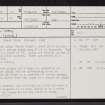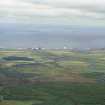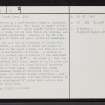Pricing Change
New pricing for orders of material from this site will come into place shortly. Charges for supply of digital images, digitisation on demand, prints and licensing will be altered.
Cnoc Urray
Broch (Iron Age)(Possible)
Site Name Cnoc Urray
Classification Broch (Iron Age)(Possible)
Alternative Name(s) Knock Urray
Canmore ID 7255
Site Number NC96NE 16
NGR NC 9838 6630
Datum OSGB36 - NGR
Permalink http://canmore.org.uk/site/7255
- Council Highland
- Parish Reay
- Former Region Highland
- Former District Caithness
- Former County Caithness
NC96NE 16 9838 6630.
(NC 9838 6630) Knock Urray (Brough) (NR)
OS 6"map, Caithness, 2nd ed., (1907)
The ruins of the broch 'Knock Urray', about 54ft in diameter, stand on a grassy mound some 87ft in diameter. The maximum height is about 10ft. Ruins are visible on the E side but no wall-face appears. There are traces of a surrounding ditch.
RCAHMS 1911, visited 1910.
This turf-covered mound, 2.7m high, is generally as described by the RCAHMS, but no surrounding ditch is visible. To the SE there is a quantity of rubble stones, which is either debris from the mound or a result of stone clearance.
The hillock is conical, and situated on a flat plateau, a position which suggests it is more likely to be a cairn than a broch. No traces of walling could be found.
Resurveyed at 1:2500.
Visited by OS (N K B) 24 November 1964.
(NC 9838 6630) Knock Urray (NR)
OS 6"map, (1967)
Knock Urray survives as a turf-covered mound as described by the previous authorities. The 'mound on mound' effect and the former existence of a ditch (RCAHMS refers) suggest the remains of a broch, but no wall faces are exposed, and there is no central depression. Erosion on the NE side reveals a content of earth and small pieces of sandstone. Commonly, when the turf has been removed or eroded from Caithness 'tullochs', a mixture of earth and stones is exposed, at least in the upper layers, but this does not preclude their classification as brochs. According to Mr Gourlay (Highland Region Archaeologist) such a content was noticeable in the excavated broch at Cross Kirk (ND07SW 4). He noted (i) that the core material between wall faces seemed to be of earth and small stones and (ii) that the large slabs of sandstone readily crumbled to fine chips. Probably for these reasons the sandstone brochs of Caithness tend to be reduced to slumped, ill-defined mounds attracting a turf cover, which contrasts strongly with the brochs further to the W which are constructed of harder rock and are more likely to retain their form.
Visited by OS (N K B) 8 December 1981.
Publication Account (2007)
NC96 5 KNOCK URRAY NC/98438 6630
Possible broch in Reay, Caithness, consisting of a grassy mound some 26.54m (87ft) in diameter and 3.05m (10ft) high and with a flat top 16.47m (54ft) in diameter on which may be a ruined broch. However no wallfaces are visible.
Sources: 1. NMRS site no. NC 96 NE 16: 2. RCAHMS 1911a, 94, no. 349.
E W MacKie 2007












